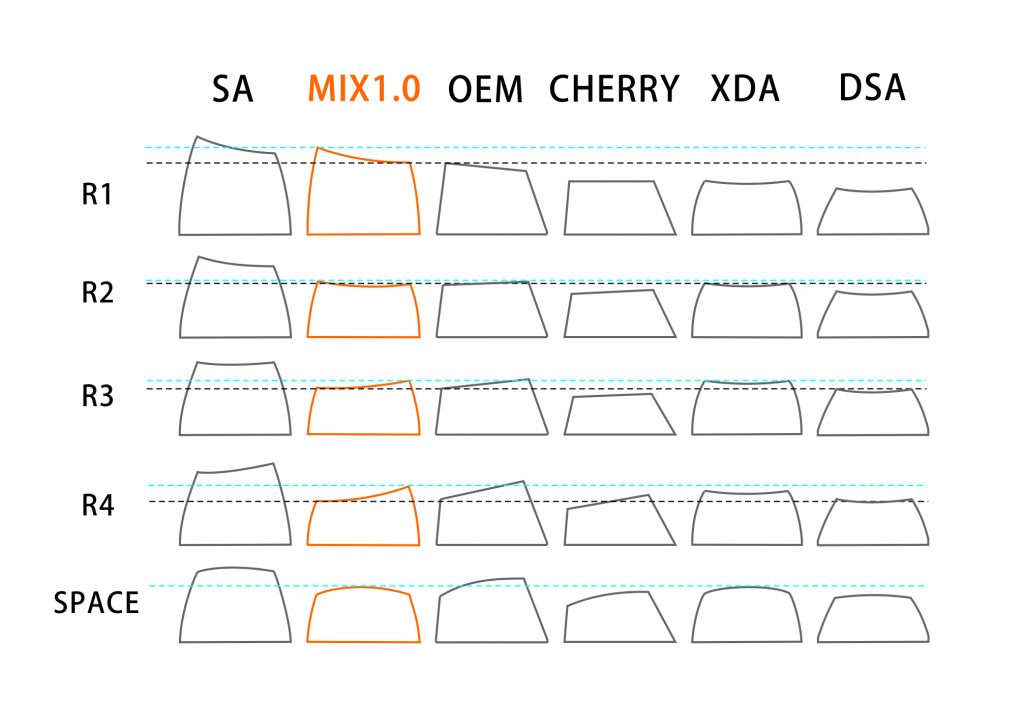If you’re in the market for a new set of keycaps, you’ve likely come across a variety of profiles to choose from. OEM, Cherry, DSA and XDA are some of the most popular keycap profiles out there–but how do they compare in terms of comfort & ergonomics, aesthetics & design, sound & feel, and durability & maintenance? In this article, we’ll take a look at how these popular keycap profiles stack up in each category to help you make an informed decision when it comes to your next set of keys.
Common Types of Keycap Profiles

When it comes to selecting a keyboard, one of the most important decisions is which type of keycaps you should choose. The profile (or shape) of the caps is what makes different keyboards unique, so it’s important to get this right if you want a comfortable typing experience and a great looking keyboard setup! Here are some of the most common types of keycaps available on the market today:
One of the most popular keycap profiles is Cherry profile. This profile is medium in height and flat compared to other profiles, making it beginner-friendly as well as producing a lower-register sound when typing or gaming. It also offers great durability due to its thicker walls. Many gamers prefer the Cherry profile and it’s often found in the top-rated keycaps for gaming. The KAT profile is similar to Cherry profile in that it is also medium-yet-taller-than-cherry, but this profile is typer-friendly and produces a sharp sound.
The MT3 profile is another popular keycap profile that is dye-sublimated and made from PBT material (a type of plastic) which gives it a more durable feel than other profiles as well as a bassy sound. The OEM profile is a sculpted option that has shorter keys with an angled design which makes them easier to access for those who may find standard keyboards too large for their hands; however this budget-friendly option produces a low register sound when typing or gaming with them.
The SA Profile has become increasingly popular in recent years due to its uniform design which gives it a tall spherical top that produces an older-keyset generation sound when typing on them; this makes them great for those seeking nostalgia through keyboarding experiences as well as providing a thock sound. The Uniform Profile has become widely popular due its full customization potential where users can switch out individual keys for different colors if desired; however this design does produce a standard sound when gaming with them.
The DSA Profile is somewhat unique compared to other keycap profiles as it has shorter keys which require some learning curve in order to be used effectively; however this unique look does produce a bassy sound which many people prefer over other options on the market today. The KAM Profile is another uniform option that has become nostalgically famous due to its resemblance to older keyboards; additionally this option produces a low register sound which some people find pleasing compared to higher register sounds produced by other options on the market today such as SA Profile mentioned previously.
Finally, one of the newest additions on the market today are XDA Profile which are flat, light and aesthetically pleasing while still producing lower bassy sounds compared to other options on the market today; these are perfect for those looking for something out of the ordinary but still aesthetically pleasing at the same time while providing excellent quality sounds while typing or gaming too! Other less common options include NP, DOM, DSS, and Asa Profiles but these are generally harder to find so if you’re looking for something specific you may need some extra research in order to find what you’re looking for!
Keycap Profile Comparison: Comparing the Different Keycap Profiles

When it comes to comparing keycap profiles, the Cherry profile is an excellent choice for those looking for a beginner-friendly option that produces a lower-register sound when typing or gaming. The KAT profile is similar to the Cherry profile in that it’s medium-yet-taller-than-cherry and produces a sharp sound, but it’s more typer-friendly. The OEM profile is great for those on a budget who are looking for something sculpted and angled that produces a low register sound.
The SA Profile is perfect for those who want an older-keyset generation look as well as a thock sound when typing or gaming; this uniform option has become increasingly popular in recent years due to its tall spherical top. The Uniform Profile is widely popular due its full customization potential, but it does produce a standard sound. The DSA Profile requires some learning curve to be used effectively, and it produces a bassy sound with them which many people prefer over other options on the market today.
The KAM Profile has become nostalgically famous due to its resemblance to older keyboards and it produces a low register sound which some people find pleasing compared to higher register sounds produced by other options on the market today such as SA Profile mentioned previously. Finally, the XDA Profile is flat and light while still producing lower bassy sounds compared to other options on the market today; these are perfect for those looking for something out of the ordinary but still aesthetically pleasing at the same time while providing excellent quality sounds while gaming or typing too!
Conclusion
It’s important to note that not all keyboards require the same type of keycaps so make sure you double check before purchasing any type of new set! Additionally, depending on what kind of keyboarding experience you’re looking for, different kinds of keycap profiles will affect your overall experience since each person will have different preferences depending on what kind of keyboarding experience they’re looking for; some prefer louder typing experiences while others prefer quieter ones – so make sure you know what kind of experience you want before committing any purchase! Finally remember that no matter what kind of keyboarding experience you’re looking for – whether it be louder typings experiences or quieter ones – each type of keycap profile listed above offer their own unique benefits so make sure you do your research carefully before making any decision!